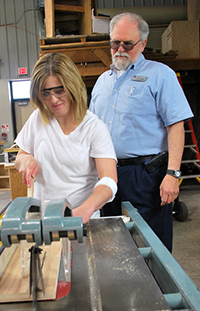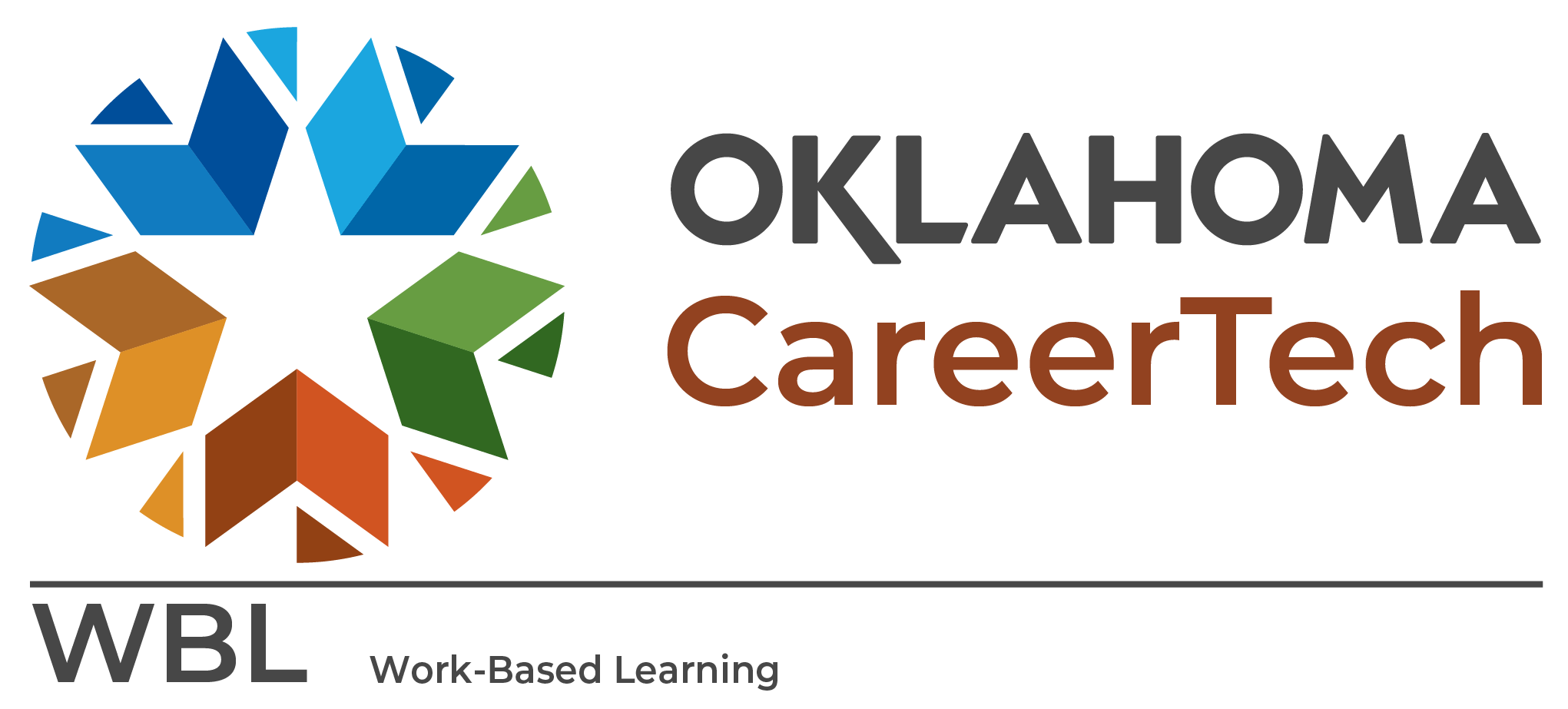Internships


Overview
What Are Internships?
Internships are often viewed as culminating WBL experiences, because they bring together skills and knowledge developed through previous career awareness, exploration, and preparation activities, connect them to classroom curricula, and allow students to apply them on the job. An internship is a WBL activity in which students spend consecutive days for a period of time (usually weeks) working for an employer. This allows them to test their interest in a career with that industry, occupation, or employer and to develop critical workplace and occupational skills. Unlike a summer or part-time job, an internship is connected to classroom learning and accompanied by structured reflection activities that help the student analyze and digest the experience. This “test drive” affords students an opportunity to confirm their future education and training decisions or, alternatively, choose another path.
Internships differ from other WBL activities by offering students hands-on skill and knowledge development through work.
Internships differ from other WBL activities by offering students hands-on skill and knowledge development through work. Students may earn credits for internships as well. Internships differ from ordinary summer or part-time jobs in two significant respects. First, they include a detailed learning plan for acquiring specific foundational skills that are required in all workplaces and specific career skills that are integrated with the classroom curriculum. Second, interns are supervised by school or district staff (in addition to employees in the workplace) before, during, and after the internships. These school-based supervisors help students prepare for their internships, make site visits, confer with interns and their workplace supervisors, assess and document progress on the learning plans, and convene periodic meetings of interns to reflect on their experiences. Interns should not fill positions that otherwise would be available to part- or full-time workers.
Internships offer employers the opportunity to get to know the next generation of employees, benefit from their work, and provide leadership development opportunities for the employees who supervise interns.
Which Students Participate in Internships?
Internships are typically offered to students in both academic and CTE classes who are going into their junior or senior years of high school. Students are best prepared to intern after they have engaged in the full continuum of WBL activities (e.g., guest speakers, workplace tours, career fairs, informational interviews, and job shadows). Student interns are usually expected to have had some form of workplace experience (e.g., part-time/summer jobs or job shadows). Other eligibility criteria options are discussed elsewhere in this chapter.
How Are Internships Structured?
Internships may be structured in multiple ways. Students enrolled in formal CTE programs may be released from school during appropriate periods to participate in an internship. Students may also participate in internships after school, on weekends, or during school breaks.

For summer internships, districts or schools will need to ensure that adequate school-based supervision (by a teacher, counselor, or other professional) is provided and included in the budget.
The length of an internship can vary. Decisions about the number of hours required for an internship and whether internships are paid and/or credit-bearing are made at the local level. In planning for internships, the WBL coordinator will want to research state or district policies that may link the possibility of earning credit to completion of a minimum number of hours in the workplace. Internships should be complemented by structured student reflections before, during, and after the internship in order to connect students' learning in the workplace with their academic work. In some locations, cooperative education (or co-op) programs that include work experience as part of a credit-bearing class may be available to CTE students. If co-op programs are offered in a district or school, the WBL coordinator should investigate the policies for students earning wages and or/credit and include CTE administrators in the planning for new internship opportunities.
Ideally, internship programs are large enough to offer internship opportunities to most juniors and seniors in a district or school. Where this is the case, most of the coordination is done at the school level by teachers, counselors, and/or career advisors, although employer recruitment may be led by the WBL coordinator. School-based staff members need to assume more significant roles than for other WBL activities, because internships should be integrated with school curricula. Significant school-based pre-internship preparation, support during internships, and post-internship reflection activities are all required for successful internships. In larger cities and districts, WBL coordinators from multiple schools and agencies that serve out-of-school youth may need to plan collaboratively to limit the possibility of multiple requests to the same employers.

How to Implement Internships
 Successful internships require collaboration, communication, and preparation by many stakeholders. The process involves:
Successful internships require collaboration, communication, and preparation by many stakeholders. The process involves:- Recruiting employers willing to provide internship opportunities.
- Preparing students for internships.
- Preparing the employees who will supervise interns.
- Designing internships that will benefit both students and employers.
- Providing close school-based supervision and guidance before, during, and after the internships.
Implementing internships can be a complex, time-consuming process that begins early in the school year and extends through the summer into the following fall. As noted in the Introduction, the following steps should be followed when starting an internship program.
- Convene the stakeholders needed to assist with implementing internships. These include employers, chambers of commerce and other industry or trade associations, school administrators, teachers, counselors, and career advisors.
- Determine the scope and structure of the internship program, including policies that will govern student selection, intern supervision, and the awarding of credit (see table below for details on the decisions that will need to be made).
- Estimate budget requirements for costs such as internship supervision during the summer and (possibly) stipends or other incentives for interns.
- Assess students’ career interests in order to target appropriate employers for recruitment.
- Recruit employers to host internships and work with them to structure internships that will benefit students, employers, and workplace supervisors.
- Select students who are interested in internships and meet the selection criteria.
- Facilitate employers’ interviews of student candidates for internships and allow the employers to make the final selections.
- Prepare students for their internships.
- Ensure that adequate supervision is provided during the internships through site visits, regular communication with workplace supervisors and students, and troubleshooting as needs arise.
- Provide for structured student reflection, both individual and group, before, during, and after their internships.
- Obtain evaluations of the activity from students and employers. Review school-based supervisor reports as well.
- Compile, document, and share results of these evaluations with key stakeholders.
- Provide structured opportunities for students to reflect about their internships and how they connect to their coursework and future education and career plans.
- Recognize participating stakeholders, especially the host employers, workplace supervisors, and the students.
The following pages provide more detailed descriptions of the tasks entailed in implementing a well-organized internship program. These steps are presented in the form of a timeline, starting early in the school year. Some steps in the timeline will not apply to classes of adult students. The timeline is flexible and can be condensed, but proper planning is essential.

Suggested Implementation Timeline
Note: Throughout this manual, the term WBL coordinator (typically, a district or school staff member) is used to refer to the individual responsible for planning and implementing WBL activities.
For internships, school-based stakeholders (counselors, teachers, and administrative staff) play important roles.

The WBL coordinator should be sure to use the WBL database, as described in the Introduction, to track employer and school contact information as well as the tasks each has agreed to carry out with respect to student internships.
The WBL coordinator should refer to the overall WBL plan (see Introduction), if there is one, to ensure that implementation of internships for students from a specific school and with specific employers is coordinated with other WBL activities planned for the same school or employers. Both the employers and the school staff will appreciate it if the WBL coordinator initiates contact for student internships in that larger context. The WBL coordinator should be careful in communicating with employers to avoid confusion if recruitment for student internships and teacher externships is occurring in the same time frame.
The WBL coordinator is assumed to be the person responsible for completing or assigning the tasks listed below, except where otherwise noted. The term “school-based supervisor” is used to refer to the person most responsible for working with students at a particular school before, during, and after their internships. Because this involves working in the summer and outside school hours, it is necessary to hire someone to carry out this work – be it a teacher, counselor, career advisor, or other professional.
Nine months to a year before the internships
There are several fundamental policy decisions that will shape a local internship program. Such decisions should be based on conversations with multiple stakeholders, including school district officials and school principals, counselors, and teachers. Making these decisions can take time, so the WBL coordinator needs to start the conversations well before the internship program will be implemented. WBL coordinators would be well-advised to start with a very small-scale program and expand later based on experience. Once a track record is built and the challenging issues resolved, expansion can go forward with greater confidence.
- Convene the appropriate stakeholders (e.g., district and/or school administrators and representatives of employers or employer associations) to design the internship program. The table that follows is designed to help staff identify internship policy and program design decisions for which stakeholder agreement is needed.
| Number of internships desired | Factors may include:
|
| Paid vs. unpaid | If paid:
|
| Credit vs. non-credit | For credit:
|
| Budget considerations | Determine needs:
|
| Student eligibility criteria | Might include:
|
| Expectations for employers |
|
| School-based internship supervision |
|
| Expectations for students |
|
| Other considerations |
|
At the beginning of the school year
- Communicate the policy and internship program design decisions to principals, teachers, counselors, and career advisors. Principals may wish to designate an individual contact at their schools to work with the WBL coordinator on the internship program; that person would then be responsible for sharing pertinent information with colleagues.
- Develop an internship program budget and identify the funding sources that will underwrite it. The budget should identify all anticipated costs, including: salary or stipends for students (if offered by the district or school), compensation for internship supervisor(s), liability insurance (if not covered by school district and/or employer policies), and recognition awards (such as gift cards) for students who successfully complete their internships (especially if they are unpaid).
- Determine which costs can be funded by the school or district and which need to be funded from other sources.
- Create a plan to solicit funding for the program, clearly identifying the process, the responsible parties, and their deadlines. Employers, local philanthropies, and municipal agencies may be asked to sponsor interns with a contribution to the program budget, even if they are unable to host interns.
- Work with school staff to determine how to obtain student registration and any necessary parent/guardian permission for internships. A sample form is provided in the Resources section.
- Teachers/counselors/career advisors: Have students begin to identify and research potential industries or employers where they would like to intern. Lists of employers produced by economic development agencies, chambers of commerce, workforce development boards, and state departments of labor or commerce are good resources for this research, along with students’ families and the internet. Each student should identify up to five local employers where they would like to intern.

- Review the employer outreach information in the Introduction.
- Begin employer outreach by targeting those that already have had successful experiences with WBL activities, have been identified by students, and/or have expressed interest in hosting an intern. A sample email for this purpose is provided in the Resources section. Expand outreach as needed, using the strategies listed below.
- Use the WBL database to track employer contacts.
- Contact advisory committee members and employers of former students.
- Meet with representatives of chambers of commerce, other industry and trade associations, and service clubs to talk about internships and ask them to encourage their members to participate. Provide whatever information they need (e.g., newsletter article or draft email to members) to make it easy for them to help. A sample email for a peer communication is included in the Resources section. The WBL coordinator might offer to attend a meeting to provide additional information about internships.
- Submit information to school newsletters, company newsletters, local newspapers, and other media outlets to recruit internship hosts.
- Send information home with students for parent awareness and recruitment of additional employers.
- Make sure that all the policy and program design decisions listed in the table preceding this section have been researched and resolved.
- Develop a protocol for working with employers to help them understand what it takes to host an intern and to plan a rewarding internship. The employer preparation information in the Resources section can be adapted to suit local needs and reflect the policy decisions that drive the local internship program. Every internship should include a learning plan that addresses foundational workplace skills and specific career-related skills. A sample learning plan template is provided in the Resources section.
- Be prepared to answer questions about details such as financial commitments expected from employers, liability coverage, etc.
- Teachers/counselors/career advisors: Have students write or update their resumes and review expectations of being in a workplace, with emphasis on recognition and understanding of both written and unwritten rules of behavior, etiquette, and job responsibilities. Introduce students to the internship application. A sample application is provided in the Resources section.
- Recruit and select school-based supervisor(s) who will work with student interns and their workplace supervisors. These may be teachers, counselors, career advisors, or other staff members. Their responsibilities will include:
- Participating in intern preparation and orientation.
- Leading student reflection activities during the internship.
- Visiting interns’ work sites at least twice.
- Touching base with students and their workplace supervisors periodically.
- Reporting on students’ progress on their learning plans.
- Troubleshooting any issues that arise during the internships.
- Leading post-internship reflection activities.

- Match student applications with confirmed internship sites, identifying three candidates for each internship, if possible. (This will likely mean that each student will be a candidate for more than one internship.) Continue to match students with internships and arrange for interviews until all accepted students have been placed.
- Schedule interviews for candidates for each internship with the employer-designated contact person. The interviews should ideally be conducted after school to avoid disruption of students’ class schedules. They may take place either at the workplace or the school. If the former, make sure students arrange their own transportation; if the latter, be sure there is a quiet place available
- Ask employer representatives for their final selections of student interns and communicate the placements to students, school-based supervisors, parents, and others, as appropriate.
- Schedule one or more workplace and school-based supervisor orientation sessions at times and locations that are convenient for all. The orientation agenda, a sample of which is provided in the Resources section, should address: expectations of school-based and workplace supervisors, the learning agreement template and its specific components, strategies for communicating with youth, time sheets, procedures for payment of interns (if applicable), provisions for individual and group student reflection activities, and documentation requirements for earning school credit. Orientation sessions should take place one to two months before internships start and should be attended by the employees who will supervise the interns’ work and the school-based supervisors. For those unable to attend an orientation session, special arrangements will need to be made for one-on-one briefings.
- Teachers/counselors/career advisors: Develop a list of interested students who meet the established eligibility criteria and are likely to be available for the duration of the internship program. Consult with counselors and career advisors, and select only those students who, in their judgment, are ready for the responsibilities of internships.
- Teachers/counselors/career advisors or school-based supervisors: Have eligible students complete applications for the internship program. A sample application is provided in the Resources section.
- Teachers/counselors/career advisors or school-based supervisors: Introduce students to job interview techniques and have them practice interviewing each other.
- Teachers/counselors/career advisors or school-based supervisors: Have students send introductory emails to the employer contacts at the workplaces for which they are internship candidates. A sample is provided in the Resources section.
Two months to one month before the internships
- Finish student interview and selection processes.
- Hold the workplace and school-based supervisor orientations.
- Work with school-based supervisors to develop student reflection assignments and procedures.
- School-based supervisors: Conduct one or more orientation sessions for students. The agenda (a sample of which is provided in the Resources section) should address: expectations for the internship; strategies for communicating with supervisors and other professionals, workplace behavior, the learning plan, the role of the school-based supervisor, time sheets and payment schedules (if applicable), reflection activities during the internship, and documentation requirements for earning credit (if applicable). If possible, parents should attend this orientation to learn how they can support their students in fulfilling internship responsibilities.
- School-based supervisors: Make sure that each student’s learning plan is complete and review it with the workplace supervisor and the student.
One month before the internships
- Reconfirm that the workplace supervisors, school-based supervisors, and students all understand their roles and responsibilities. Make sure all interns have arranged transportation to and from their workplaces.
- Review logistics and procedures with the school-based supervisors and make sure that plans are in place for student reflection assignments and activities. If the school building is not open during the summer, an alternate location for student reflection meetings will need to be identified.
Two weeks before the internships

- Send reminder emails to both workplace and school-based supervisors, confirming details of internships along with student names and contact information.
- Be available to answer questions from employers, students, parents, and school-based supervisors.
- School-based supervisors: Schedule meetings or check-ins with workplace supervisors periodically throughout the internship.
- Site visits are typically scheduled early in the internship and at about the three-quarters point. More frequent telephone or email check-ins are advised.
- Be sure the workplace supervisors and the student interns are aware of whom to contact with any questions or concerns at any time during the internship.
One week before the internships
- Reconfirm any arrangements that were not in place at the last check and send a quick reminder email to school-based and workplace supervisors and students.
During the internships
- School-based supervisors: Check in with employers on the first or second day of the internships to make sure students were prompt and the internships are off to good starts. Intervene with students and/or workplace supervisors as needed.
- School-based supervisors: Conduct first visits to employer sites (generally after one week) and review progress on learning agreement goals with students and their workplace supervisors. Skill attainment should be demonstrated and documented. If skill development is not progressing satisfactorily, work with the student and supervisor to reconfigure the internship.
- School-based supervisors: Send progress reports summarizing students’ attainment of the skills detailed in their learning plans to the person to whom they report.
- School-based supervisors: Collect student time sheets (see sample in Resources section) weekly and touch base by phone or email with the interns and their workplace supervisors. If the district or school is handling payment of salaries or stipends, paychecks can be delivered when time sheets are collected.
- School-based supervisors: Conduct second site visits (generally about three-quarters of the way through the internships) to review students’ performance. Review learning plan progress and submit progress reports.
- School-based supervisors: Distribute student reflection materials throughout the internship as scheduled during the planning process. Review, track, and grade (if necessary) individual student reflection assignments during the internships. Convene student meetings for group reflections at planned intervals during the internships. As a local option, students who do not have internships but are working at summer or after-school jobs may be invited to join these discussions.
- School-based supervisors: Review student reflections promptly. Students might identify issues and concerns that they do not mention during weekly check-ins or site visits. Intervene as needed.
- School-based supervisors: Maintain records for credit-earning options as needed and submit required paperwork.
One day to one week after the internship
- School-based supervisors or WBL coordinator: Send thank-you emails to both the employers and the workplace supervisors (which may be the same person in a small organization).
- School-based supervisors or WBL coordinator: Distribute internship evaluations to workplace supervisors, collect and review completed evaluations, and move promptly to follow up on negative responses.
- School-based supervisors or WBL coordinator: Distribute internship evaluations to students.
- School-based supervisors or WBL coordinator: Analyze evaluations and identify common themes to be shared with the internship planning team, school-based staff, workplace supervisors, and students. Move promptly to follow up on negative evaluations and capture lessons learned to use for future program improvements.
- School-based supervisors: Complete final reports on each students' performance on their learning plans, in consultation with their workplace supervisors, and share them with the students and their teachers and counselors.
- School-based supervisors: Have students complete thank-you notes to their workplace supervisors. Review the notes before students send them.
- School-based supervisors or WBL coordinator: Conduct a post-internship reflection meeting with all student interns, focusing on how their internships connect with the courses they will take in the future. Present them with recognition awards (gift cards or other), if they were included in the budget.
- Recognize employer hosts and workplace supervisors. One form of recognition could be a celebratory event, where students showcase what they have learned. Co-hosting the event with a chamber of commerce or other local organization or agency provides a wider audience, helps with recruitment for future internships and other WBL activities, and acknowledges the efforts of the employers that hosted internships. Invite the school-based supervisor(s) and interns’ classroom teachers, counselors, career advisors, and principals.
- Teachers/counselors/career advisors or school-based supervisors: Have students produce culminating projects or reports on their internship experiences and how they connect to school curricula. Have students request letters of recommendation from their workplace supervisors, which can be used when they seek employment in the future.
- Teachers/counselors/career advisors or school-based supervisors: Identify ways to use student internship experiences in the classroom to illustrate for all students the connections between academic curricula and career success.

Internship Resources
Note: These forms can be printed with expanded space for written responses or adapted in other ways.
WBL coordinator:
School:
Employer:
Student:
Copyright © 2020 CareerTech



